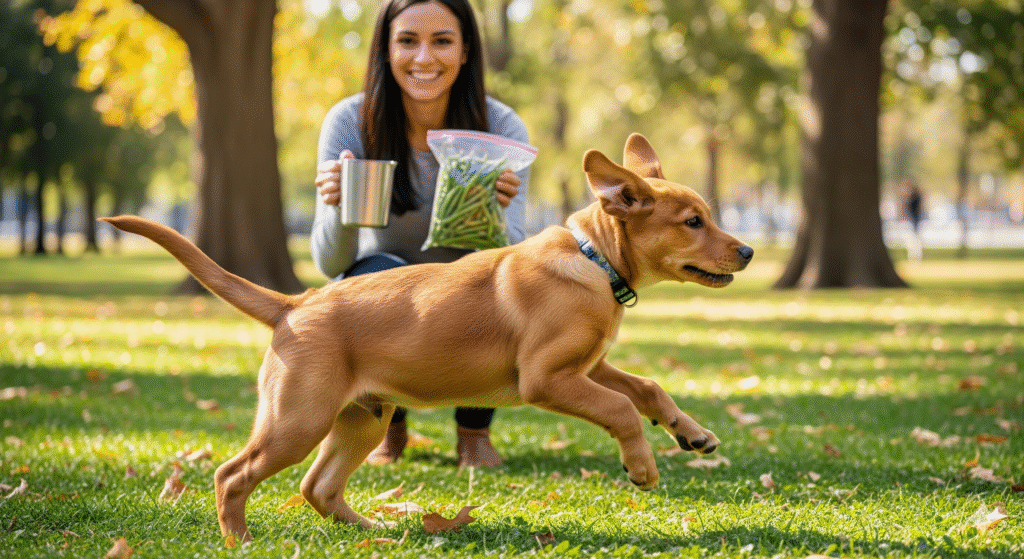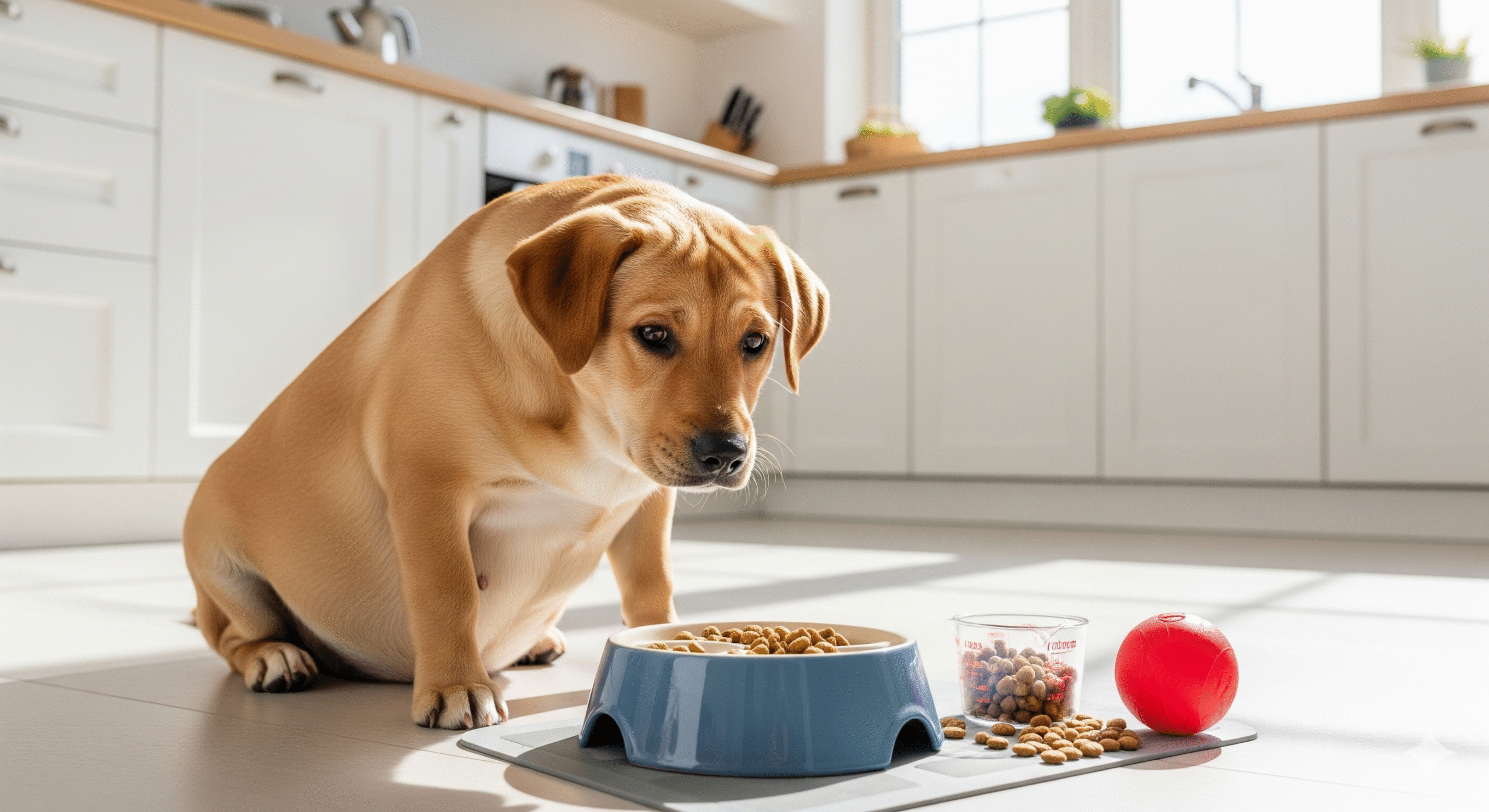A chubby puppy with rolls of extra fat might look cute, but carrying excess weight is one of the most serious health threats a growing dog can face. Puppyhood is a critical period for skeletal development, and extra pounds place immense stress on developing joints, potentially leading to lifelong issues like hip dysplasia, arthritis, and cruciate ligament tears. Furthermore, overweight puppies often become overweight adults, setting them up for a higher risk of diabetes, heart disease, and respiratory problems. The good news is that with a careful, science-backed approach, you can safely get your puppy back on track without compromising their growth or nutrition.
This guide provides a compassionate and effective roadmap for helping your overweight puppy achieve a healthy weight. We’ll focus on safe, sustainable strategies that promote growth while shedding fat, because puppy weight loss is a delicate balancing act.
Here’s what we’ll cover:
✔️ How to tell if your puppy is truly overweight (body condition scoring)
✔️ The serious health risks of excess weight during growth
✔️ A step-by-step diet plan for safe weight loss, including portion control and food choices
✔️ Safe exercise routines that protect joints while burning calories
✔️ How to manage treats and snacks without depriving your pup
✔️ When to involve your veterinarian and rule out medical causes
Let’s create a healthy, happy future for your puppy, one step at a time.
Is My Puppy Overweight? How to Body Condition Score 🧐
Forget the number on the scale. Breed standards vary wildly, so the best way to assess your puppy’s weight is through a Body Condition Score (BCS).
The Ideal Body Condition (BCS 3/5 or 5/9):
- Ribs: You should be able to easily feel their ribs under a thin layer of fat. You should not see them.
- Waist: When looking down from above, you should see a clear waist behind the ribs.
- Tuck: When viewing from the side, the abdomen should tuck up from the rib cage to the hips.
Signs Your Puppy is Overweight (BCS 4/5 or 6/9+):
- Ribs are difficult to feel under a thick layer of fat.
- No visible waist; the body is rectangular or oval-shaped from above.
- No abdominal tuck; the belly is saggy or parallel to the ground.
- Fat pads over the base of the tail and on the neck.
Why Puppy Obesity is So Dangerous: More Than Just “Puppy Fat” ⚠️
Excess weight is never healthy, but it’s especially damaging during the growth phase.
- Orthopedic Damage: A puppy’s bones, joints, and ligaments are still developing. Extra weight forces growth plates to close incorrectly and stresses immature joints, dramatically increasing the risk of:
- Hip Dysplasia
- Elbow Dysplasia
- Torn cruciate ligaments (ACL tears)
- Arthritis later in life
- Increased Disease Risk: Overweight puppies are more likely to become overweight adults, facing higher risks of:
- Diabetes
- Heart and respiratory disease
- Certain cancers
- Reduced Quality of Life: They have less energy, get tired easily, and can’t play as freely.
The Safe Weight Loss Plan: Diet First 🍽️
Step 1: Consult Your Veterinarian 🩺
This is non-negotiable. Your vet will:
- Rule out medical causes like hypothyroidism.
- Determine your puppy’s ideal target weight.
- Recommend a daily calorie goal. Never starve a growing puppy.
Step 2: Measure Everything! 📏
“Eyeballing” portions is the #1 reason for overfeeding.
- Use a standard measuring cup or, even better, a kitchen scale for ultimate accuracy.
- Follow the feeding guidelines on your puppy food bag for your puppy’s ideal weight, not their current weight.
Step 3: Choose the Right Food 🥩
- High-Quality Protein: Supports lean muscle mass during weight loss.
- Moderate, Healthy Fat: Necessary for brain development but calorie-dense.
- High Fiber: Helps your puppy feel full without adding calories. Look for foods with healthy fibers like beet pulp or pumpkin.
- Consider a “Healthy Weight” Formula: Many brands offer puppy formulas designed for weight management with optimized nutrient levels.
Step 4: Implement Smart Feeding Strategies 🧠
- Split Daily Food into 3-4 Meals: This keeps metabolism steady and prevents hunger-induced begging.
- Use a Puzzle Feeder or Snuffle Mat: This slows down eating and provides mental stimulation, making mealtime more satisfying.
- No Free-Feeding: Always pick up the bowl after 15-20 minutes.
The Safe Exercise Plan: Low-Impact is Key
The goal is to burn calories without stressing joints.
- Avoid: Forced running on pavement, long jogs, high-impact jumping for toys, and agility jumps.
- Embrace:
- Multiple Short, Leashed Walks: Several 10-15 minute walks per day are better than one long, exhausting one.
- Swimming: The ultimate low-impact, calorie-burning exercise. Perfect for overweight puppies.
- Gentle Play: Short sessions of fetch on soft grass, hide-and-seek with treats, or gentle tug-of-war.
- Mental Exercise: Training sessions, food puzzles, and nose work are tiring and burn calories without any joint impact.
Managing Treats: The Hidden Calorie Culprits 🍪
You don’t have to eliminate treats; you have to get smart about them.
- Use Their Kibble: Deduct a portion of their daily kibble allotment and use those pieces as training treats throughout the day.
- Choose Low-Calorie Options: Use tiny pieces of fresh vegetables like carrots, green beans, cucumber, or blueberries.
- Never Feed from the Table: This encourages begging and adds uncontrolled calories.
- Account for Everything: Every treat, dental chew, and spoonful of peanut butter counts toward the daily calorie total.
Final Checklist for a Healthier Puppy ✅
☑️ I have scheduled a vet visit to rule out medical issues and get a target weight.
☑️ I am using a measuring cup or kitchen scale for every meal.
☑️ I can easily feel my puppy’s ribs and see a waist.
☑️ I have replaced high-calorie treats with veggies or pieces of kibble.
☑️ I am focusing on low-impact exercises like swimming and short walks.
☑️ I am patient, understanding that healthy weight loss is a slow process for a growing puppy.

Ensuring your puppy gets a complete and balanced diet is the most important thing you can do for their long-term health. While most owners choose a high-quality commercial kibble, some prefer a different route. If you’re interested in preparing their meals yourself, it’s critical to do it correctly. Our guide to Homemade Puppy Food Recipes (Vet-Approved) will show you how to start.






